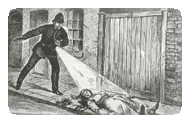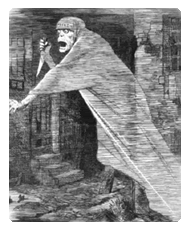On the casebook.org website recently, a discussion has centered around the interest in the Jack the Ripper case and whether that interest is "murder porn" or at the very least, misogyny. Some posters even posit a misogyny against women in general and the women who post on Casebook in particular. Opponents of "ripperology" claim that since the majority of people who research the Ripper case are men, then it must be an interest in the horrific injuries to the women, or a latent desire to injure women, that drives men to continue that interest. Aside from the leap to conclusion and prejudice on the part of writers who believe this with no data to support the claims, it is also worth looking at just why people are interested in the case.
Number 1: He was never caught.
This is by far the most obvious and yet most important factor. I have no idea about and have no interest in whether there are Ted Bundy or Jeffrey Dahmer websites where people rehash the crimes and endlessly debate the injuries, etc. I have seen books on the cases, and read them with interest as cases in and of themselves. There is a difference here. The crimes themselves are of secondary interest to the character and nature of the offender. Some see this as slighting the victim, but for me, the real worth in studying these cases lie in (perhaps a pipedream) the possibility of recognizing and heading off future Bundys and Dahmers. We must learn the nature of the perpetrator, not the nature of the victim, to do this. The latter presupposes that the victim had something to do with his or her fate-this is a ludicrous and fairly offensive suggestion. While human nature and basic decency has us grieve for the victims, the look to the future retards this grieving process in favor of hopefully preventative analysis.
Number 2: The choice of victims is of interest because of their circumstances and what that says about the era.
Some of the same critics who chastise students of Ripperology say that the victims are forgotten and even exploited. Jack the Ripper killed these women-we know their names and backgrounds (although some of this information is debatable) and they have become part of the learning inherent in the case. I also see this chastisement as hypocritical, as these women would never have been known at all if not for the Ripper. Their status was and is a blight on mankind, and only thoughts of helping future potential victims and even people who live(d) in such lowly status can help now.
A few years ago, I wrote the following piece, and I wanted to repost it here.
Forget Jack, Am I a Misogynist?Inherent in the study of any crime against women is the questioning of the researcher’s motives. Why are people fascinated with crime and, more specifically, the crime of murdering women? With the advent of both the realization of the existence of serial killers and our study of them comes society’s preoccupation with the underlying motivation of that study. This questioning comes up most often because serial killers (mostly men) target the object of their sexual or psychological hatred (mostly women). Jack the Ripper, as the first acknowledged modern sexual serial killer, leaves those who research him open to the charge of misogyny. Moreover, since the majority of "Ripperologists" are men, the charge of misogyny is even more ubiquitous. Even Philip Sudgen, in The Complete History of Jack the Ripper, felt compelled to answer this accusation. Sugden states,
Some would have it that those who read or write about the murders are misogynists. I am not a misogynist. Nor for that matter, is any serious student of the case personally known to me. It should be obvious from the most cursory glance at the literature, moreover, that what really fascinates people about the story is the question of the killer’s identity. (2-3)
But it can be argued that it is society at large that perpetuates the misogyny through fictional representations of the Ripper killings rather than those who would seek to either solve or understand them. Judith Walkowitz writes in City of Dreadful Delight that
The Whitechapel murders have continued to provide a common vocabulary of male violence against women, a vocabulary now more than one hundred years old. Its persistence owes much to the mass media’s exploitation of Ripper iconography. Depictions of female mutilation in mainstream cinema, celebrations of the Ripper as a "hero" of crime intensify fears of male violence and convinces women that they are helpless victims. (228)
Walkowitz points to the media’s preoccupation with the injuries to the women and the profession of the victims that have proliferated in the mainstream audience’s exposure to the case since its initial reporting in the newspapers. Real followers and researchers of the Ripper murders are cognizant of the fact that, as Sugden rightly says, the mystery of the actual perpetrator is by far the most interesting factor of the case, not a prurient interest in the mutilation of women. When filmmakers and novelists use Jack the Ripper as a basis for their own fictions, they are playing to mainstream culture’s biases and preconceptions about Jack the Ripper, rather than seeking to shed any light or investigate the motivations of the real killer. One merely has to sit through the execrable Klaus Kinski film Jack the Ripper to realize that Jack the Ripper is only used to lure audiences to the theater to watch a film that has nothing, apart from the time period, to do with the real case.
The question then arises, "Why the morgue photographs of the victims in the various books of the case? Aren’t these an indulgence in prurience and, therefore, misogynistic?" I would argue the opposite: except for one victim’s marriage photograph, we have no extant pictures of the victims apart from the autopsy photos. Therefore, in order to put a human face on the victims and to pay at least some tribute to the woman who were the victims of the Ripper, we have no choice but to use these iconographs.
Another question may arise concerning the profession of the women. Are we more interested in Jack’s victims because they were prostitutes? Because of the Victorian Era’s refusal to deal with the problems of poverty and subjugation of women, some were forced to resort to prostitution to make a living. Yet, Victorian Britain’s solution to the vice of prostitution was to blame the prostitute for "enticing" men into consorting with them. Therefore, the Contagious Diseases Act and other such legislation punished the women and labeled them as deviants and nymphomaniacs rather than dealing with the underlying reasons why women became prostitutes. Or, to the opposite extreme, society refused to acknowledge that prostitution existed at all. Women who prostituted themselves were referred to in newspapers as "unfortunates," if mentioned at all, as if these women were, according to Calvinist dictates, one of the people who were not "selected" for salvation. Shani D’Cruze writes,
There is a remarkable silence in Sectional Occurrence Books and most of the petty sessions records used here on the subject of prostitution, although we know of the broad police powers under the vagrancy laws in regard to prostitutes on the streets, even outside the Contagious Disease Acts. Other sources, for example Parliamentary Papers, indicate very clearly the preoccupation of local government with prostitution and "disorderly houses.(2)
With no help and/or willful blindness from society and only antipathy from the police and courts, these women had no recourse but to keep themselves "very much to themselves." This made them susceptible to someone, like Jack, who targeted women to satisfy whatever psychotic agenda he had while being fairly certain that the discovery of the victims would not bring all of London’s wrath down on him. This turned out to be not completely accurate, as George Bernard Shaw and Annie Besant were working to achieve social justice and Shaw, at least, wrote about the murders as being something that at least brought the plight of such women to the public’s attention.
It can be said that the profession of his victims is an added inducement to students of Jack, because of what their circumstances represented to the Victorians and that it forced the Victorians to at the very least acknowledge the existence of such women. But it was Jack, not students of the crimes, that chose the victims. When the police narrowed Ted Bundy’s victims to pretty young women with straight, long hair parted in the middle, were they indulging in a prurient desire to single out such women? Is it misogynistic to identify, using victimology, the likely objects of a killer’s attentions? And, since it is more likely for a man to be the serial killer and for women to be his victims, is it misogynistic to concentrate on this scenario when it plays itself out in real life?
Contrary to the assumption, students of the Jack the Ripper murders concentrate more on the identity of the killer rather than the sexuality of those involved. If reams of paper are devoted to the exact injuries of the victims and what these may mean about the sexuality of the person who perpetrated those injuries, these are not without a substantive purpose. Jack the Ripper was, at the very least, a misogynist. Of course, this is a laughable appellation when seen in conjunction of his career as a brutal murderer. But Jack’s sexual motivation is fair ground for research. These subjects of sex will sell books, (such as pontificating and speculating on Prince Eddy’s sexuality and the question of the ferocity of Mary Kelly’s injuries as opposed to the others’), but the overwhelming majority of books are concerned with "revealing," "closing," and "solving" the crimes. In other words, these books are concerned with identifying the murderer. This is research, not misogyny.















